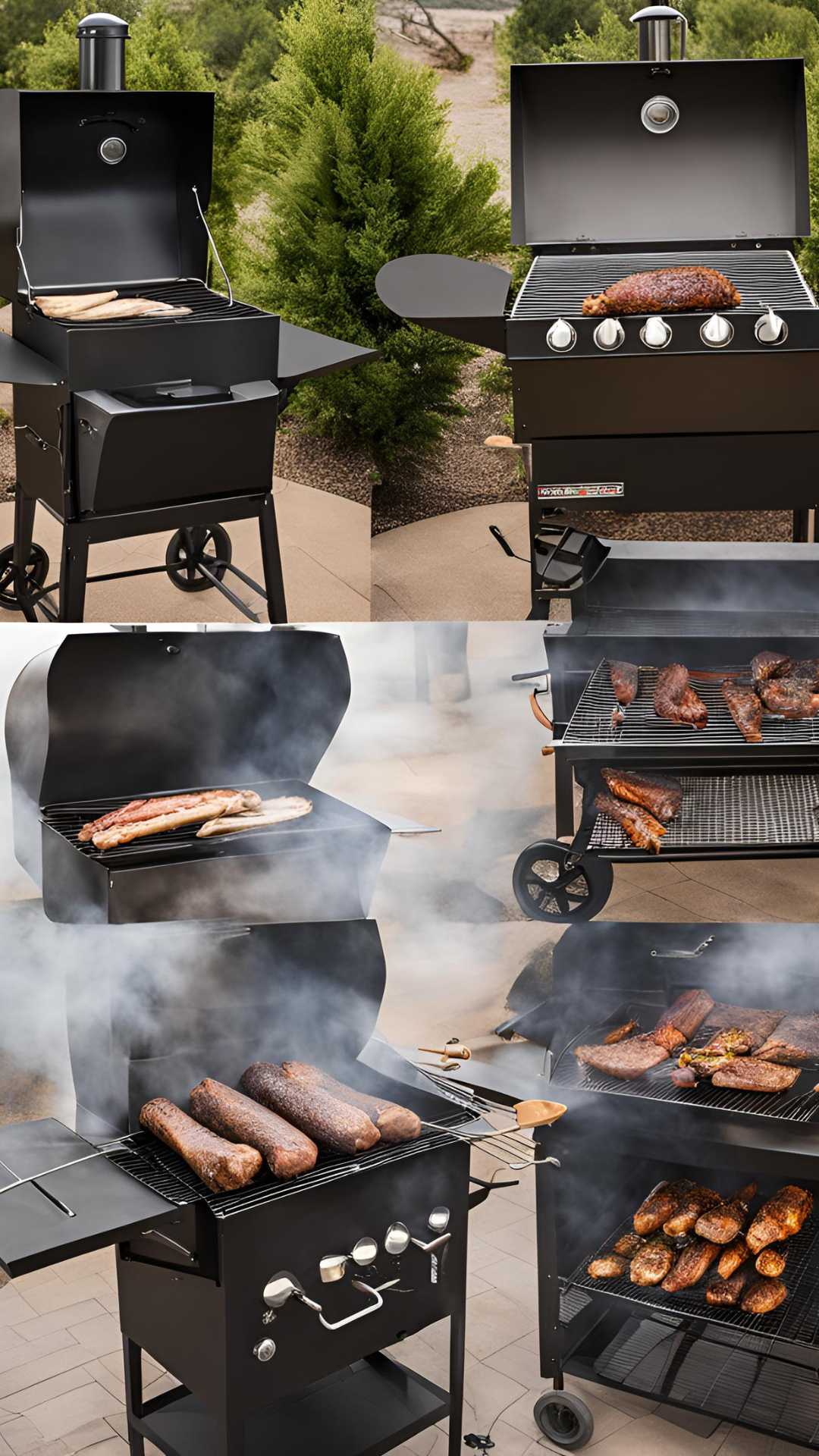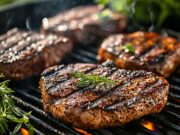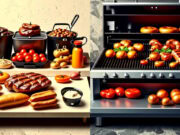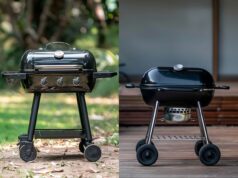Smoking meats and other foods has evolved into an art form, providing rich flavors and tender textures that enhance any meal.
When selecting a smoker, two popular options stand out: offset smokers and vertical smokers. Each type offers unique features, advantages, and challenges, making the decision significant for both novice cooks and experienced pitmasters.
This article examines the key differences between these two styles, assisting you in determining which option aligns best with your cooking style, available space, and budget.
Key Takeaways:
- Offset smokers offer a rich, deep flavor profile and high cooking capacity, but require a learning curve to master temperature control.
- Vertical smokers provide ease of use and consistent temperature, but have limited cooking space and may lack the depth of flavor of offset smokers.
- When choosing a smoker, consider your cooking preferences, available space, and budget to determine which type will best suit your needs.
Understanding Offset Smokers
Offset smokers represent a distinct category of grilling equipment that employs a separate firebox to produce heat and smoke, which then circulates into the main cooking chamber where the food is placed.
The design of offset smokers typically features a horizontal cooking chamber alongside a firebox, facilitating efficient heat distribution and delivering a rich smoky flavor that many barbecue enthusiasts appreciate.
Renowned brands such as Traeger and Dyna-Glo have refined this technology, offering users a range of options tailored to different cooking styles and budgets.
What is an Offset Smoker?
An offset smoker is a specialized type of smoker that includes a separate chamber, known as a firebox. This design allows you to burn wood or charcoal while channeling heat and smoke into the main cooking area.
This unique configuration helps you maintain a consistent temperature and promotes even cooking, which is essential for achieving that perfect smoky flavor. The firebox not only provides a designated space for fuel but also regulates air intake, a crucial factor in controlling smoke output.
When considering various models, you will find options with larger cooking areas or additional racks, which enhance versatility for different types of foods. This flexibility allows for both indirect and direct grilling. If you frequently entertain or need to prepare large quantities of food, selecting a model with a spacious cooking surface can significantly enhance your overall experience, enabling you to cook multiple dishes simultaneously without compromising on flavor.
How Offset Smokers Work
Offset smokers operate by utilizing a firebox positioned alongside the main cooking chamber. In this setup, the fuel source—whether it is wood chunks, charcoal, or wood pellets—is ignited to produce heat and smoke.
This design facilitates a distinct separation between the cooking and combustion processes, which enhances temperature control. As the wood or charcoal burns, the heat generated travels from the firebox into the cooking chamber through a specially designed flue or opening. Effective airflow management is critical, as it regulates the amount of oxygen feeding the fire, influencing both the smoke flavor profile and the overall cooking temperature.

Smokers typically come equipped with adjustable vents on both the firebox and the cooking chamber, enabling precise adjustments of airflow and smoke density. Inside the cooking chamber, smoke circulates, enveloping the food and imparting rich, deep flavors, aided by the convection currents generated by the heat.
By mastering these elements—temperature management, airflow, and smoke distribution—you can significantly enhance your barbecuing experience.
Advantages of Using Offset Smokers
One of the primary advantages of using offset smokers is their ability to produce an exceptional smoky flavor in meats, thanks to their design that promotes indirect cooking and allows for a longer smoking duration.
This unique construction not only enhances the depth of flavor but also enables consistent temperature control throughout the cooking process. The large cooking capacity of offset smokers means that you can accommodate various cuts of meat simultaneously, making them ideal for gatherings or events.
These smokers offer versatility in cooking techniques, allowing you to experiment with methods such as hot smoking, cold smoking, and even roasting. The combination of these features ensures that each barbecue session yields tender, juicy, and richly flavored results that are sure to impress your friends and family.
Disadvantages of Using Offset Smokers
Despite their numerous advantages, offset smokers present a steep learning curve, particularly for beginners. They require a solid understanding of temperature control and airflow management to achieve optimal results. This knowledge is crucial, as even slight variations in temperature can significantly impact the flavor and tenderness of the meat.
New users may experience frustration due to the constant need for monitoring, as maintaining a consistent heat level can be challenging. The performance of an offset smoker can vary greatly based on the operator’s skill level; those who are still learning may encounter uneven cooking or prolonged smoking times due to their inexperience.
This variability can lead to inconsistent outcomes, making it essential for beginners to dedicate time to practice and refine their techniques to enhance their smoking experience.
Understanding Vertical Smokers
Vertical smokers, commonly known as upright smokers, are engineered to provide a space-efficient cooking area. This design makes them an excellent option for individuals with limited backyard space who still wish to engage in the art of smoking meat.
What is a Vertical Smoker?
A vertical smoker is a specialized cooking device that employs a vertical design to stack cooking racks, allowing you to smoke multiple levels of food simultaneously using a single heat source located at the bottom.
This unique layout maximizes space efficiency, making it an excellent option for those looking to prepare large quantities of meat or vegetables at once. Vertical smokers consist of essential components such as the firebox, water pan, and adjustable vents, all of which are vital to the cooking process.
The vertical configuration enhances heat distribution and smoke circulation by promoting an upward flow of heat and flavorful smoke, ensuring that your food is evenly enveloped across all racks. As a result, you can enjoy tender, smoky dishes infused with rich flavors, showcasing the art of barbecue at its finest.
How Vertical Smokers Work
Vertical smokers operate by positioning a heat source, typically charcoal or electric, at the base of the unit, often accompanied by water pans to regulate humidity and enhance the smoking process.
As the heat rises, it generates a natural flow of warm air that circulates within the cooking chamber, allowing the smoke to envelop the food evenly. This design ensures that meats and other items are exposed to consistent temperatures, promoting effective cooking.
Some models feature digital temperature controls, enabling users to set precise heat levels, which further enhances the smoking experience. By maintaining optimal temperatures, these features assist in achieving the desired smoky flavor while preventing overcooking.
Consequently, users can experience a more manageable cooking process, resulting in tender, flavorful dishes that truly highlight the art of smoking.
Advantages of Using Vertical Smokers
One of the standout advantages of vertical smokers is their space-efficient design, which allows you to smoke a variety of meats in a compact area without compromising ease of use or maintaining temperature consistency.
This compact design makes them especially appealing for individuals with limited outdoor space or for those who enjoy smoking their meats at home. Vertical smokers typically come equipped with multiple cooking racks, enabling you to prepare different cuts simultaneously, which is highly beneficial for gatherings or events.
Their user-friendly operation often includes digital controls and built-in thermometers, ensuring precise temperature management that promotes thorough cooking. As a result, these smokers consistently deliver moist, flavorful results, allowing you to achieve the perfect bark and smoke ring on your meats, whether it’s brisket, ribs, or poultry.
Ultimately, the combination of efficiency and reliability makes vertical smokers a preferred choice for both novice and experienced pitmasters.
Disadvantages of Using Vertical Smokers
While vertical smokers provide numerous benefits, they also have certain limitations, such as a reduced cooking capacity compared to offset smokers. This can affect the depth of flavor achieved in larger cuts of meat.
This limitation may be particularly evident during gatherings or events when a larger quantity of food is required, prompting enthusiasts to explore alternative options. Users might find that the vertical design can lead to uneven cooking temperatures, especially when multiple items are placed in close proximity. Consequently, some may notice that the flavor profile of their smoked dishes lacks the richness that a more spacious cooking environment can offer.
Furthermore, those who enjoy experimenting with various wood chips and smoking techniques might feel restricted, as the vertical smoker may not support diverse approaches as effectively as its horizontal counterparts.
Comparative Analysis: Offset Smokers vs. Vertical Smokers
When comparing offset smokers to vertical smokers, there are several key factors to consider, including flavor and smoke quality, ease of use, cooking capacity, and the overall value of your investment in the smoking experience.
Flavor and Smoke Quality
Flavor and smoke quality are essential factors to consider when selecting between offset and vertical smokers, as each type presents distinct characteristics that significantly influence the final taste of the smoked meat.
When examining the nuances of these smokers, it is important to account for elements such as the type of wood used, heat distribution methods, and cooking techniques. Offset smokers are often preferred for their ability to deliver rich, deep flavors, allowing for longer smoldering of wood, which enhances the smokiness of the meat. In contrast, vertical smokers typically employ a convection-style heating method that ensures even heat distribution, potentially resulting in a more subtle flavor profile.
Additionally, the choice of wood—whether hickory, mesquite, or fruitwood—plays a crucial role, as each type imparts unique characteristics that can elevate the overall smoking experience.
Ease of Use and Learning Curve
The ease of use and learning curve associated with offset and vertical smokers can vary significantly, affecting both beginners and seasoned users in their pursuit of competition-level barbecue performance.
Offset smokers often require a more in-depth understanding of temperature control and airflow management, while vertical smokers tend to be more straightforward, allowing you to achieve excellent results with minimal experience. Users of vertical models can typically grasp the fundamentals quickly, enabling them to concentrate on mastering flavors and techniques.
On the other hand, if you choose an offset smoker, be prepared to invest time in learning proper fire management and the nuances of smoke flavor profiles. Therefore, for those new to the art of smoking, a vertical smoker may serve as a more user-friendly entry point, helping you build a solid foundation before transitioning to the complexities of an offset system.
Cooking Capacity and Versatility
When evaluating offset and vertical smokers, it is essential to consider cooking capacity and versatility, as these factors determine the types of meals you can prepare and the number of guests you can serve.
For individuals who enjoy hosting gatherings or family barbecues, understanding the unique features of each smoker can significantly impact meal planning. Offset smokers generally provide larger cooking areas, allowing for whole cuts of meat or multiple racks of ribs, making them ideal for larger events. Conversely, vertical smokers are designed to maximize space by stacking food, which is particularly advantageous for those with limited outdoor space who still wish to prepare a variety of dishes, including vegetables, seafood, and smaller meats.
By assessing how each smoker accommodates different food sizes and preparation methods, you can identify which model aligns best with your culinary vision and entertaining requirements.
Price and Value
Price and value are essential factors to consider when choosing between offset and vertical smokers, as they can significantly influence your long-term enjoyment and satisfaction within your budget.
When examining the price ranges of these two types, you may find that offset smokers typically fall into the moderate to high price bracket, often reflecting their larger cooking capacity and quality of construction materials. In contrast, vertical smokers generally offer more budget-friendly options, making them an appealing choice for beginners or those with limited space.
It is crucial to evaluate not only the initial cost but also the overall durability and performance each smoker provides. While larger offset models may boast superior heat retention and flavor infusion thanks to their design, vertical smokers can deliver excellent results while requiring less fuel and space.
By assessing these features alongside their price tags, you can gain a clearer understanding of the value each type of smoker brings to your outdoor cooking experience, ensuring a wise investment that aligns with your financial means.
What to Consider When Choosing a Smoker
Choosing the right smoker requires careful consideration of several critical factors, including your unique cooking style and preferences, the space you have available for setup, and the budget you have allocated for this culinary investment.
Cooking Style and Preferences
Understanding your cooking style and preferences is crucial when selecting a smoker, as it enables you to identify the type of equipment that will best meet your needs for achieving smoky meat perfection.
Whether you enjoy the slow, low-and-slow approach to barbecue or prefer a more hands-on, active grilling session can significantly influence this decision. If you favor larger cuts, such as brisket or a whole pork shoulder, an offset smoker may be the ideal choice for you; it is renowned for producing rich, deep flavors and maintaining an even temperature.
On the other hand, if a vertical smoker aligns more closely with your culinary goals—particularly for tasks like preparing a variety of sausages or ribs—its compact design and quicker heating times may better suit your requirements. Additionally, factors such as preferred wood types and desired flavor intensity play an essential role in shaping your overall smoking experience.
Available Space and Setup
The available space for your smoker setup is a crucial factor to consider, as it can significantly influence your choice between offset and vertical smokers based on their design and footprint.
As an outdoor enthusiast, you should evaluate how the size of your smoker aligns with the layout of your patio or backyard. For instance, if space is limited, opting for a more compact model like a vertical smoker can be advantageous, as it typically occupies less ground space while still offering adequate smoking capacity.
Portability is also essential, particularly if you plan to relocate your smoker for gatherings or store it away during the off-season. Ease of use is another important consideration; smokers that require extensive assembly or constant adjustments may not be ideal if you prefer a straightforward outdoor cooking experience.
By carefully considering your setup requirements, including storage solutions, you can ensure that you select a smoker that truly complements your outdoor lifestyle.
Budget and Investment
Budget is a key consideration when choosing a smoker, as it will guide your options and help determine which models offer the best performance and value for your investment.
With a wide array of smokers available, ranging from budget-friendly charcoal models to high-end electric and pellet varieties, you may face a challenging decision. While a lower upfront cost may appear appealing, it is essential to evaluate the features that are necessary for achieving your desired smoking experience.
For example, investing in a smoker with better insulation can result in lower fuel consumption and more consistent temperatures, ultimately leading to greater long-term satisfaction. Therefore, balancing initial costs with quality features can significantly impact not only your immediate enjoyment but also the smoker’s overall durability and performance over time.
FAQ
As with any culinary equipment, you may have common questions about offset smokers and vertical smokers, particularly concerning their functionality, maintenance, and performance.
Frequently Asked Questions
What is the difference between offset smokers and vertical smokers?
Offset smokers have a horizontal chamber where the heat and smoke source is located, while vertical smokers have a tall, vertical design with the heat source at the bottom.
Which one is better for smoking meat?
It depends on personal preference and the type of meat being smoked. Offset smokers are better for larger cuts of meat, while vertical smokers are better for smaller cuts and are more versatile in terms of smoking different types of meat.
What are the advantages of using an offset smoker?
An offset smoker allows for more control over temperature, produces a more traditional smoked flavor, and has a larger cooking capacity compared to vertical smokers.
Why would someone choose a vertical smoker over an offset smoker?
Vertical smokers are often more compact and easier to store, have a quicker heat-up time, and allow for more even heat distribution for consistent smoking.
Which type of smoker is more beginner-friendly?
Vertical smokers are generally easier for beginners to use due to their simplicity and quicker learning curve.
Is one type of smoker more expensive than the other?
It varies depending on the brand and features, but in general, offset smokers tend to be more expensive due to their larger size and heavier construction materials.



















































